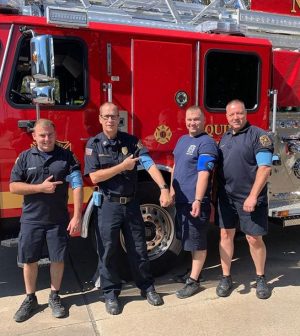- Navigating Your Midlife Crisis: Embracing New Possibilities
- City Raccoons Showing Signs of Domestication
- Mapping the Exposome: Science Broadens Focus to Environmental Disease Triggers
- One Week Less on Social Media Linked to Better Mental Health
- Your Brain Changes in Stages as You Age, Study Finds
- Some Suicide Victims Show No Typical Warning Signs, Study Finds
- ByHeart Formula Faces Lawsuits After Babies Sickened With Botulism
- Switch to Vegan Diet Could Cut Your Greenhouse Gas Emissions in Half
- Regular Bedtime Does Wonders for Blood Pressure
- Dining Alone Could Mean Worse Nutrition for Seniors
Firefighters’ Blood Pressure Can Rise When Duty Calls

Working in an already dangerous environment, the blood pressure of firefighters jumps when they get an emergency call, new research shows.
That could be risky for those who already have high blood pressure, experts say.
“All emergency and first responders should be aware of their health,” said senior author Deborah Feairheller, director of the clinical cardiac program at the University of New Hampshire. “They should know what their typical blood pressure level is and be aware of how it fluctuates. Most important, if they have high blood pressure, they should make sure it is well-controlled.”
While almost half of American adults have high blood pressure, the rate is much higher among firefighters.
“The current data show that almost 75% of firefighters have hypertension, and less than 25% have their blood pressure under control,” Feairheller said.
High blood pressure increases the risk of heart attack and stroke, and more than half of deaths among firefighters in the line of duty are related to heart disease, the American Heart Association is (AHA) noted.
For the study, 41 volunteer and city firefighters from suburban Philadelphia and the Dover, N.H., area wore portable blood pressure monitors during an on-call shift lasting at least 12 straight hours.
In addition to the automatic blood pressure readings, participants were asked to trigger the monitor to take a reading whenever there was an emergency call or they were in a stressful situation.
Participants included 37 men and four women (average age: about 41). All were white, had high blood pressure and were overweight or obese. They had an average of nearly 17 years of job experience.
While wearing the monitor, their average blood pressure was 131/79.3 mm Hg and average heart rate was 75.7 beats per minute. (A normal blood pressure is below 120/80.)
On average, systolic (top number) blood pressure jumped 19.2 mm Hg with fire calls and 18.7 mm Hg with medical calls. Diastolic (lower number) blood pressure rose 10.5 mm Hg with fire calls and 16.5 mm Hg with medical calls, compared with readings immediately before the calls.
Systolic blood pressure is the force your heart exerts on the arteries as it beats; diastolic blood pressure measures force in between beats.
The researchers found that compared with firefighters’ average readings, systolic blood pressure was 9% higher during fire calls, and diastolic blood pressure was 9% higher during medical calls.
Average heart rate rose 10 beats per minute with fire calls and 15 beats per minute for medical calls.
There were no significant differences in blood pressure, heart rate or blood pressure surge levels when comparing responses among fire calls, medical calls, riding in an emergency vehicle or false alarms.
The findings will be presented Saturday at the online annual meeting of the AHA. Research presented at meetings is typically considered preliminary until published in a peer-reviewed journal.
“The public knows the value that emergency responders provide to communities,” Feairheller said in an AHA news release. “We hope to increase awareness that many firefighters have hypertension and that their blood pressure can increase to very dangerous levels when responding to emergency calls.”
More information
The U.S. National Heart, Lung, and Blood Institute has more on high blood pressure.
SOURCE: American Heart Association, news release, Nov. 5, 2021
Source: HealthDay
Copyright © 2025 HealthDay. All rights reserved.










